Students should refer to Light ICSE Class 10 Physics Notes and solutions below. Our teachers have provided numerical problems and solutions for chapter Light in ICSE Class 10 Physics. These notes are really useful if you are preparing for ICSE exams. concise physics class 10 solutions are also very important for Physics students.
ICSE Class 10 Physics Light Numerical Problems
Students can refer to the Numerical Problems prepared for Chapter Light in Class 10 ICSE. These notes will be really helpful for the students giving the Physics exam in ICSE Class 10. Our teachers have prepared these concept notes based on the latest ICSE syllabus and ICSE books issued for the current academic year. Please refer to Chapter wise notes for ICSE Class 10 Physics provided on our website.
Light ICSE Class 10 Physics Revision Notes
(a) Concept Notes
➢The speed of light in air/vacuum is 3 × 108 m/s.
➢ A medium is said to be optically denser if light slows down in it.
➢ A medium is said to be rarer if light speeds up in it.
➢ When a ray of light travels from a rarer medium to a denser medium, it bends towards the normal.
➢ When a ray of light travels from a denser medium to a rarer medium, it bends away from the normal.
➢ The conditions when light travelling from one medium to another goes undeviated :
(i) Optical density of both the mediums is the same.
(ii) Angle of incidence is zero. i.e., light falls normally on the surface.
➢ Refractive index has no unit.
➢ When light passes from one medium to another its frequency does not changes but wavelength, speed and direction changes.
➢ When light passes from rarer to denser medium its wavelength decreases.
➢ When light passes from denser medium to rarer medium its wavelength increases.
➢ In case of minimum deviation of light while passing through the prism, the refracted ray inside the prism is parallel to the base of the prism.
➢ Factors affecting the angle of deviation of light travelling through the prism are :
(i) The angle of incidence.
(ii) The material of the prism (i.e., refractive index).
(iii) The angle of prism (A).
(iv) The colour or wavelength (λ) of light used.
➢ Factors affecting lateral displacement of light passing through a rectangular glass block :
(i) The thickness of glass block.
(ii) The angle of incidence.
(iii) The refractive index of the glass and therefore, the wavelength of light used.
➢ Cause of refraction is that light has different speeds in different medium.
➢ The refractive index of a transparent medium is always greater than 1.
➢ Factors affecting refractive index of a medium :
(i) Nature of medium.
(ii) Physical conditions such as temperature.
(iii) The colour or wavelength of light.
➢ Speed of light in glass is 2 × 108 m/s and in water is 2.25 × 108 m/s.
➢ Refractive index of glass is 1.5, for water is 1.33 and for diamond is 2.41
➢ Refraction of light through a rectangular glass block

➢ Refraction of light through a glass prism
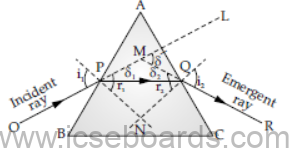
➢ Applications of refraction of light
(a) Real and apparent depths of object in water
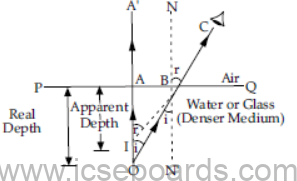
(b) Bending of stick under water

➢ Critical angle is the angle of incidence in the denser medium for which angle of refraction in the rarer medium is 90°.
When a ray of light travels from a denser to a rarer medium, with an angle of incidence greater than critical angle, then no refraction takes place and the entire light is reflected back in the denser medium. This is known as total internal reflection.
Essential conditions for total internal reflection to take place :
(i) Light must travel from a denser to a rarer medium.
(ii) The angle of incidence should be greater than the critical angle for the given pair of medium.

➢ Total internal reflection in a triangular glass prism
(a) An equilateral prism ( 60°,60°,60°)

(b) A prism with angles (60°,30°,90°)

(c) A prism with angles (45°,45°,90°)
(i) To deviate the incident ray by 90° i.e. (d = 90°)
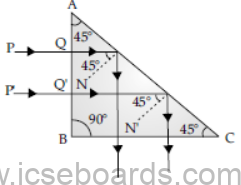
(ii) To deviate the incident ray by 180° i.e. ( d = 180°)
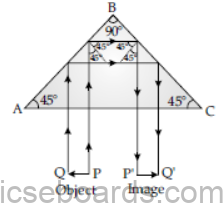
➢ Comparison between total internal reflection and reflection from a plane mirror
(i) In total internal reflection, light enters from a denser to a rarer medium, whereas in reflection from a plane mirror, light can be incident from any medium.
(ii) There is no loss of energy in total internal reflection, as the entire light is internally reflected, whereas in case of reflection from plane mirror, there is a loss of energy due to absorption and refraction of light.
Know the terms
➢ Refraction : The change in direction of the path of light, when it passes from one transparent medium to another transparent medium is called refraction. It is a surface phenomenon.
➢ Denser medium : A medium is said to be optically denser if the speed of light in it decreases.
➢ Rarer medium : A medium is said to be optically rarer if the speed of light in it increases.
➢ Angle of incidence : It is the angle between incident ray and the normal to the surface at point of incidence.
➢ Angle of refraction : It is the angle between the refracted ray and the normal at the point of incidence.
Laws of refraction :
➢ Ist Law : The incident ray, the refracted ray and the normal at the point of incidence, all lie in the same plane.
➢ IInd Law : The ratio of the sine of the angle of incidence i to the sine of the angle of refraction r is constant for the pair of given medium. This constant is called refractive index. This Law is also called Snell’s Law.
➢ Refractive index : The refractive index of the second medium with respect to the first medium is defined as the ratio of the sine of the angle of incidence in the first medium to the sine of the angle of refraction in the second medium.
Lateral Displacement : The distance between the incident ray produced and the emergent ray when light travels through the rectangular glass slab is called lateral displacement.
Angle of deviation : The angle between the emergent ray and the incident ray produced when light passes through a prism is called angle of deviation.

Refraction Through a Lens
Revision Notes
(a) Concept Notes
➢ A lens is a transparent refracting medium bounded by two surfaces, both of which are either spherical in shape or one is curved and other is spherical. A lens can be regarded as being made up a set of prisms. (A lens is not made up of prisms.)
➢ There are mainly two types of lenses :
(I) Convex or converging lens.
(ii) Concave or diverging lens.
➢ Convex or converging lenses are thin at the edges and thick at the middle.
➢ Concave or diverging lenses are thick at the edges and thin at the middle.
➢ The principal axis of a lens is the line joining the centers of the two spheres of the two surfaces of which lens is a part of.
➢ Optical center of a thin lens is the point on the principal axis of the lens through which a ray of light passes undeviated.
➢ For a convex lens, the first focal point is a point F1 on the principal axis of the lens such that the rays of light coming from it, after refraction through the lens, become parallel to the principal axis of the lens.
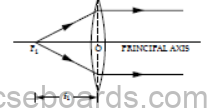
➢ For a concave lens, first focal point is a point F1 on the principal axis of the lens such that the incident rays of light appearing to meet at it, after refraction from the lens become parallel to the principal axis of the lens.

➢ For a convex lens, the second focal point is a point F2 on the principal axis of the lens such that the rays of light incident parallel to the principal axis, after refraction from the lens, pass through it.
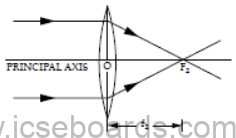
➢ For a concave lens, second focal point is a point F2 on the principal axis of the lens such that the rays of light incident parallel to the principal axis after refraction from the lens, appear to be diverging from this point.

➢ A concave lens always produces a virtual, erect and diminished image of a real object.
➢ The power of a lens is the reciprocal of its focal length measured in metre. It is measured in units of dioptre (D).
➢ A convex lens of small focal length may be used as a simple magnifying glass or a reading lens. For this, the object is kept between the optical centre and the focus of the lens, when it is used in this manner, it is also known as a simple microscope.
➢ The magnification produced by a lens is the ratio of a size of the image produced by it to the size of the object.
➢ Refraction of an oblique parallel beam by a convex lens :

➢Refraction of an oblique parallel beam by a convex lens :

Distinction between a real and virtual image:

Relative positions of the object and image in a convex lens :

Relative positions of object and image in a concave lens :

Difference between the image formed by a convex lens and by a concave lens

➢ The deviation produced by a lens in the path of rays refracted through it, is a measure of its power. Power of a lens is positive for the convex lens and negative for the concave lens.
➢ Power of lens (in D) = 1/f
➢ Magnifying power : The magnifying power of the microscope is given as :
➢ Magnifying power = 1 + D/f
Ray diagram for location of image in magnifying glass :

➢ Focal Length of Lens : The distance between focus and optical centre of the lens is called focal length of a lens.
➢ Focal Plane : The plane passing through the focus and perpendicular to the principal axis is called Focal plane.
➢ Aperture : The effective diameter of the circular outline of a spherical lens is called its aperture.
➢ Centre of curvature of a surface of a lens is the centre of the sphere of which lens is a part. A lens having two spherical surfaces has two centres of curvatures.
➢ Radius of curvature is the distance between the optical centre and centre of curvature.
➢ Sign Conventions :
• All distances are measured from the optical centre of the lens.
• Distances measured in the direction of the incident ray are taken as positive and opposite to the direction of the incident ray are taken as negative.
• Distances measured upwards and perpendicular to principal axis are taken as positive, whereas distances measured downwards are taken as negative.
➢ Lens formula
1/v -1/u = 1/f
Where, u = object distance ( always negative)
v = image distance ( can be positive or negative)
f = focal length ( positive the for convex lens and negative for the concave lens)
➢ Lenses are used in eye defect correction, magnifying glass, telescope, camera.
Light ICSE Class 10 Physics: Spectrum
Revision Notes
➢The phenomenon of splitting of white light by a prism into its constituent colours is known as dispersion.
➢The band of colours seen, on passing white light through a prism is called the spectrum.
Cause of dispersion :
➢The cause of dispersion is the change in speed of light with wavelength. When white light enters the first surface of a prism, light of different colours due to their different speeds in the ➢glass gets deviated toward the base of prism through different angles.
➢ Dispersion by a prism :

➢ The angle of deviation depends upon,
(i) angle of incidence at first surface
(ii) angle of prism
(iii) refractive index of the material.
➢ Wavelengths and frequencies of different colours in white light :

➢ The complete electromagnetic spectrum in the increasing order of their wavelength (or decreasing order of their frequency ) is given below :
(1) Gamma rays, (2) X-rays, (3) Ultraviolet rays, (4) Visible light, (5) infrared radiations, (6) Microwaves, and (7) Radio waves.
Thus infrared spectrum is the part of the spectrum just beyond the red end while the ultraviolet spectrum is the part of the spectrum just before the violet end.

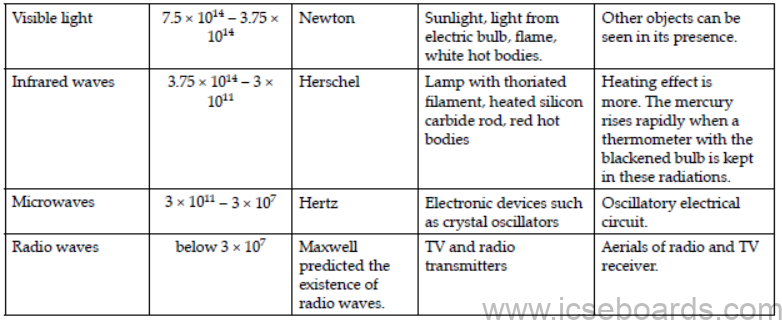
Properties Common to all Electromagnetic Spectrum :
(i) The electromagnetic waves of the entire wavelength range do not require any material medium for their propagation.
(ii) They all travel with the same speed in a vacuum which is the same as the speed of light in vacuum i.e., 3 × 108 m/s.
(iii) They exhibit the properties of reflection and refraction.
(iv) These waves are not deflected by the electric and magnetic fields.
(v) These waves are transverse waves.
➢ Properties and uses of the electromagnetic spectrum :
➢ γ-rays
These rays are the most energetic electromagnetic waves of wavelength less than 0.01 nm.
Properties of γ-rays are as follows :
(i) They cause fluorescence when they strike on the fluorescent materials as zinc sulphide.
(ii) They can easily penetrate through the thick metallic sheets.
(iii) γ-rays can easily penetrate through the human body.
Uses of γ-rays are as follows :
(i) They are used in the treatment of cancer and tumours.
(ii) They are used to produce nuclear reactions.
(iii) γ-rays are used to preserve the foodstuffs for a long time.
(iv) It provides valuable information about the structure of the atomic nucleus.
➢X-rays
X-rays discovered by German physicist W Roentgen, having a range of wavelength from 0.01 nm to 10 nm.
They are produced when highly energetic cathode rays are stopped by a heavy metal target of high melting point.
Properties of X-rays are as follows :
(i) They have high penetrating power.
(ii) They strongly affect the photographic plate.
(iii) They cause fluorescence in certain material such as zinc sulphide, etc.
Uses of X-ray are as follows :
(i) In surgery for the detection of fracture, foreign bodies like bullets, stone in a human body, etc.
(ii) For detecting faults, cracks, flaws and holes in the final product of metals.
(iii) For curing untrackable skin diseases and malignant growths.
(iv) For investigation of the structure of crystals, arrangement of atoms, etc.
➢ Ultraviolet Radiation
It was discovered by Ritter in 1801. They are produced by some special lamps and very hot bodies. Ultraviolet rays coming from the sun are absorbed by the ozone layer in the earth‘s atmosphere. The wavelength range varies from 10 nm to 400 nm.
Properties of ultraviolet radiation are as follows :
(i) They can pass through quartz but absorbed by glass.
(ii) They obey the laws of reflection and refraction.
(iii) These radiations travel in a straight line with a speed of 3 × 108 m/s in air (or vacuum).
(iv) They can be scattered by dust particles in the atmosphere
(v) They cause health hazards like skin cancer, if our body is exposed for a long period.
Uses of ultraviolet radiation are as follows :
(I) For sterilizing purposes.
(ii) For detecting the purity of gold, eggs, ghee, etc.
(iii) For producing vitamin D in food of plants and animals.
➢ Visible Light
It is the narrow region of the electromagnetic spectrum which can be detected by the human eyes. Its wavelength ranges from 390 nm to 700 nm.
Property of visible light is as follows :
The visible light emitted or reflected from the object around us provides the information surrounding us.
Uses of visible light are as follows :
It is used in photography, photosynthesis and to see objects around us.
➢Infrared Radiation
It was discovered by Herschel. They are sometimes called heat wave, because their absorption causes the heating effect in the bodies and surroundings. They are produced by hot bodies and molecules. Its range is from 700 nm to 1 mm.
Properties of infrared radiation are as follows :
(I) They do not affect ordinary photographic film.
(ii) They obey the laws of reflection and refraction.
(iii) They are absorbed by the glass but are not absorbed by rock salt.
(iv) They are detected by their heating property.
(v) They are less scattered by the atmosphere.
Uses of infrared radiation are as follows :
(I) They are used in photography at night and also in mist and fog.
(ii) They are used for therapeutic purpose.
(iii) They are used in remote control of TV and other gadgets.
(iv) They are used as signals during the war.
➢ Microwaves
Microwaves are the electromagnetic wave of the wavelength having a range of 10-3 m to 0.3 m.
They are produced by special vacuum tubes.
Uses of microwaves are as follows :
(I) They are used for aircraft navigation.
(ii) They are used for cooking purposes.
(iii) They are used for observing the movement of trains while sitting in a microwave operated control room.
➢ Radiowaves
These are the waves of longest wavelength amongst all the electromagnetic waves. They have a wavelength above 10 m. They show all the properties of electromagnetic waves.
Uses of radiowaves are as follows :
(I) It is used in ground wave propagation.
(ii) It is used in sky wave propagation.
(iii) They are used mainly in radar communication and television transmission.
IMPORTANT FORMULAS
1) Refractive index

2) Refractive index

3) Refractive index

4) When a ray after refraction, retraces its path then:
a𝜇b = 1 / b𝜇a
(where ‘a’ is the rarer medium and ‘b’ is the denser medium)
5) In case of refraction through optical slabs:
i) Incident ray is parallel to emergent ray.
ii) Angle of incidence is equal to angle of emergence.
6) Refractive index a𝜇b = 1 /sinc where ‘a’ is medium (air), ‘b’ is any other denser medium and ‘c’ is the critical angle.
7) In case of refraction through prism:
Angle of incidence + Angle of emergence = Angle of prism + Angle of deviation
∠i + ∠e = ∠A + ∠D or ∠δ
8) In the minimum deviation position of prism:
i) Angle of incidence = Angle of emergence
∠ I = ∠ e
ii) Angle of refraction at first face = Angle of refraction at second place
∠ r1 = ∠r2
9) The magnification of lens is:
Size of image =

or I/o =v/u
10) For simple microscope:
Magnification = 1 + D/f
(where ‘D’ is the least distance of distant vision and ‘f’ is focal length of convex lens)
11) f – number = The size of aperture =

12) Power of Lens: The power of lens is the measure of convergence or divergence produced by it.

where, f = focal length and P = Power
Light ICSE Class 10 Physics VELOCITY OF LIGHT IN DIFFERENT MEDIA
Medium Velocity of Light ( ms-1 )
Vacuum (air) 3 x 108
Water 2.25 x 108
Ruby 1.7 x 108
Ordinary glass 1.96 x 108
Crown glass (1.86 to 1.96) x 108
Flint glass 1.75 to 1.85 x 108
Diamond 1.24 x 108
REFRACTIVE INDEX OF SOME COMMON SUBSTANCES
Substance Refractive Index (μ)
Water 1.33
Ruby 1.76
Glass (ordinary) 1.53
Alcohol 1.37
Crown glass 1.53 to 1.61
Sulphuric Acid 1.43
Flint glass 1.62 to 1.71
Paraffin oil 1.44
Diamond 2.42
Ice 1.31
Light ICSE Class 10 Physics IMPORTANT PROBLEMS & SOLUTIONS
1) The angle of incidence in air for a ray of light is 450. If ray travels through water of refractive index 4/3, find angle of refraction.

2) The refractive index of a material is 1.4. If velocity of light in vacuum is 3 x 108 ms-1, find the velocity of light in the material.

3) A glass block 2.4 cm thick is placed over a stamp. Calculate the heights through which image of stamp is raised. Refractive index of glass is 1.5.

4) A coin placed under a glass appears raised by 12 mm. If refractive index of glass is 1.5, calculate the actual thickness of glass slab.

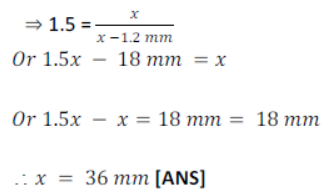
5) A rectangular tank 6 metre deep is full of water. By how much the bottom appears to be raised, given refraction index of water = 𝟒/𝟑 ?
Ans. Here real depth of water = 6 m
Apparent dept = 𝑥 metres
Let Refractive index 𝜇 = 4/3

Hence the distance by which bottom appears to be raised = 6 – 4.5 = 1.5 𝑚𝑒𝑡𝑟𝑒 [ANS]
6) If the speed of light in vacuum is 3 x 108 ms-1and refractive index of water is 𝟒/𝟑 calculate the speed of light in water.
Ans. ∴ Speed of light in water = (3.0 x 108) x 3/4
⇒ Speed of light in water = 2.25 x 108 ms-1 [ANS]
7) A stamp collector uses a lens (convex) of focal length 7 cm to examine a stamp. What is the power of lens?
Ans. Power = 1/f = 1/7 = 0.1428 cm [ANS]
8) A glass slab 2.5 cm thick is placed over a coin. If the refractive index of glass is 3/2, find the height through which coin is raised.
Ans.

= 2.5 / 1.5 = 1.66 cm = 1.7 cm
∴ Distance through which coin is raised = (2.5 – 1.7) cm = 0.8 cm [ANS]
9) A light of wave length 500 nm in air enters a glass place of refractive index 1.5. Find its wave length in glass.
Ans. Refractive index = λa / λm = 1.5
Wave length is glass medium ( λm ) = 500 / 1.5 = 333.33 m [ANS]
10) A 10 cm tall object is placed on the principal axis of a convex lens of focal length 20 cm and at a distance of 10 cm from it. Find by accurate scale diagram, the position nature and size of image.
Ans. Let the scale be 1 cm = 10 cm
∴ Size of object = 10 cm = 1 cm
∴ Distance of object from lens = 10 cm = 1 cm
∴ Focal length of lens = 20 cm = 2 cm
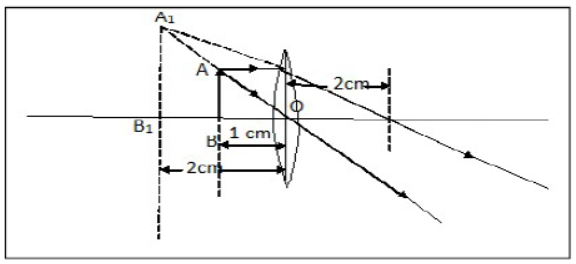
On constructing ray diagram, it is found;
Size of image A1 B1 = 2 x 10 cm = 20 cm
Distance of image from optical centre OB1 = 2 x 10 cm = 20 cm
Nature of Image is erect, virtual and enlarged. [ANS]
11) A 5 cm tall object is placed on the principal axis of diverging lens of focal length 15 cm and at a distance of 10 cm from it. Find the nature, position and size of image.
Ans. Let the scale be 5 cm = 1 cm.
∴ Size of object 5 cm = 1 cm
∴ Distance of object from lens = 10 cm = 2 cm
∴ Focal length of lens = 15 cm = 3 cm

Distance:
On constructing ray diagram, it is found
Size of image = A1 B1 = 0.6 cm = 0.6 x 5 cm = 3.0 cm [ANS]
Distance of image from lens = OB1 [ANS]
Nature of Image is erect, virtual and diminished. [ANS]
12) An object 6 cm high is placed at a distance of 18 cm from a convex lens of focal length 6 cm. Find by scale diagram:
(i) The Nature of Image
(ii) Position of Image
(iii) Size of Image
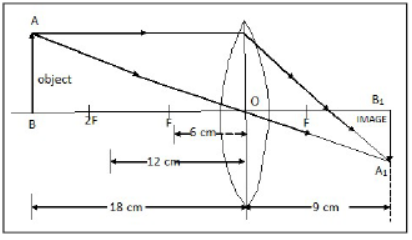
Ans. Scale 2 cm = 1 cm
A1 B1 image size is 3 cm at a distance ɤ = 9 cm
i) Nature of Image – Real and inverted.
ii) Position is at 9 cm i.e. between F and 2F.
iii) Size of Image = A1B1 = 3 cm i.e. smaller in size. [ANS]
13) The refractive index of water with respect to air is a𝝁w and that of glass with respect to air is a𝝁g. Express the refractive index g of glass with respect to water.
Ans. Let C1, C2 and C3 be the velocities of light in air, water and glass respectively. Then by definition:

14) What is the refractive index of an opaque body?
Ans. Infinity because the speed of light for an opaque medium is O.

15) Velocity of light in vacuum (air) is _________________.
(3 x 108)
16) Velocity of light in water is _______________.
(2.25 x 108)
17) Velocity of light in Diamond is ____________.
(1.24 x 108)
18) Velocity of light in ordinary glass is ________.
(1.96 x 108)
19) Refractive index of water is ______________.
(1.33)
20) Refractive index of Diamond is ___________.
(2.42)
21) Refractive index of ice is ___________.
(1.31)
22) Critical angle for Diamond is only ____________.
(240 )
23) Critical angle is the angle of _________ for which the angle of ______ is ____.
(Incidence, refraction, 900 )
24) The speed of light in glass is 2 X 105 km/s.
What is the refractive index of glass.
Ans. Speed of light in glass = 2 x 105 km/s
= 2 x 108 m/s
Refractive index of glass is
μglass = 3x 108 / 2×108
= 1.5 [ANS]
25) A ray of light passes through a right angled prism as shown in the figure. State the angles of incidence at the faces AC and BC.

Ans. Angle of incidence at Face AC is = 450
Angle of incidence at Face BC = 00

26)


27) Wavelength and frequency are given. Fill up the name of the wave.

(i) Gamma rays,
(ii) X – rays
(iii) Ultraviolet rays
(iv) Visible light
(v) Infrared waves
(vi) Microwaves
(vii) radio waves
28) Give the colours and the range of the wavelengths constituting a visible spectrum.
Ans. The wavelength ranges for various colours of visible spectrum are given below:


29) Write the range of wavelength of
(i) Infrared spectrum
(ii) Ultraviolet spectrum
Ans. (i) 8000 Å to 107 Å
(ii) 100 Å to 4000 Å
30) Give the approximate range of wavelengths in vacuum associated with UV rays and visible light.
Ans.
(i) For UV radiations the range is 3 x 10-8 m to 4 x 10-7 m.
(ii) For visible light, the range is 4 x 10-7 to 8 x 10-7 m.
31) A TV station transmits waves of frequency 200 MHz. Calculate the wavelength of the waves if their speed in air is 3.0 x 108 ms-1.
Ans.
Given V = 200 MHz
C = 3 x 108 ms-1

We hope you liked Light ICSE Class 10 Physics Notes and solutions. If you have any questions please post them in the comments section below



